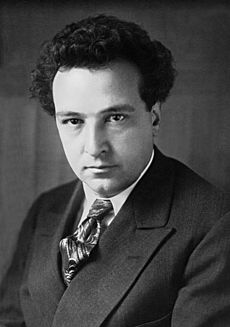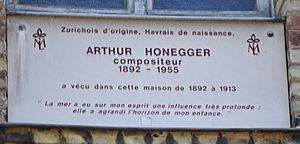Arthur Honegger facts for kids
Arthur Honegger (born March 10, 1892 – died November 27, 1955) was a famous composer from Switzerland. He was born in France and spent most of his life in Paris. He was part of a group of composers called Les Six.
His most famous work is probably Antigone. He wrote this opera between 1924 and 1927. It was based on an old Greek play by Sophocles. The opera first showed in 1927 with amazing sets by Pablo Picasso and costumes by Coco Chanel. But his most often played piece is Pacific 231. This orchestral work was inspired by the powerful sound of a steam locomotive.
Contents
Who Was Arthur Honegger?
Arthur Honegger was born in Le Havre, France. His parents were Swiss. His full name was Oscar-Arthur Honegger, but he never used "Oscar." He first studied music in Le Havre, learning harmony and violin.
He later studied at the Zurich Conservatory for two years. From 1911 to 1918, he went to the Paris Conservatoire. There, he learned from famous teachers like Charles-Marie Widor. He showed his first compositions in Paris in 1916. In 1918, he wrote the ballet Le dit des jeux du monde. Many people see this as his first truly unique work.
In 1926, he married Andrée Vaurabourg. She was a pianist and also studied at the Paris Conservatoire. They had an unusual living arrangement. They lived in separate apartments because Arthur needed quiet time to compose. He would visit her and her mother for lunch every day. They lived apart for most of their marriage. They had one daughter, Pascale, born in 1932.
Honegger's Musical Journey
In the early 1920s, Honegger became very well known. This was thanks to his "dramatic psalm" called Le Roi David (King David). This piece is still performed by choirs today. Between World War I and World War II, Honegger wrote a lot of music.
He composed music for the epic 1927 film Napoléon. He also wrote nine ballets and three vocal stage works. One of his stage works, Jeanne d'Arc au bûcher (1935), is a "dramatic oratorio." Many consider it one of his best works. He also worked with Jacques Ibert on an opera called L'Aiglon (1937).
During this time, he wrote Danse de la chèvre (1921). This piece is for solo flute and is very popular among flute players. It is lively and charming, showing Honegger's direct style.
Life During Wartime
Honegger always stayed connected to Switzerland, his parents' home country. But when World War II started and the Nazis invaded, he could not leave Paris. He joined the French Resistance, a group fighting against the occupation. The Nazis generally let him continue his work.
However, the war made him very sad. During and after the war, he wrote his last four symphonies. These are considered some of the most powerful symphonic works of the 20th century. His Second Symphony is for strings and features a solo trumpet. His Third Symphony, called Symphonie Liturgique, has three movements that sound like a Requiem Mass. This symphony was written in 1946, right after the war ended.
In contrast, his Fourth Symphony, "Deliciae Basilienses" ("The Delights of Basel"), is more gentle. He wrote it to remember peaceful times in Basel, Switzerland, during the war.
A Love for Trains
Honegger was a big fan of trains. He once famously said, "I have always loved locomotives passionately. For me they are living creatures." His symphonic movement Pacific 231 (1923) shows a steam locomotive. This piece made him famous early in his career.
His friend Georges Tzipine often performed Honegger's works. Tzipine conducted the first recordings of some of his pieces.
Later Life and Legacy
In 1953, Honegger wrote his last composition, A Christmas Cantata. He passed away at home in Paris on November 27, 1955, from a heart attack. He was buried in the Saint-Vincent Cemetery in Paris. The French government gave him a state funeral, even though he remained a Swiss citizen.
Honegger's music often used Bach-like counterpoint, strong rhythms, and colorful harmonies. His style was often more serious than other members of Les Six. He was good friends with Darius Milhaud, another member of Les Six. Milhaud dedicated a string quintet to Honegger's memory.
Honegger was featured on the Swiss twenty franc banknote from 1996 to 2017. Many of his recordings as a conductor have been re-released on CD.
Notable Compositions
These are some of Arthur Honegger's important works. The numbers (like H 75) come from a full list of his music by Harry Halbreich.
- Orchestral Music :
-
- 1930 : H 75 First Symphony
- 1941 : H 153 Second Symphony for strings and trumpet in D
- 1946 : H 186 Third Symphony (Symphonie Liturgique)
- 1946 : H 191 Fourth Symphony in A (Deliciae basiliensis)
- 1950 : H 202 Fifth Symphony in D (Di tre re)
- Symphonic Movements :
- 1923 : H 53 Pacific 231 (Symphonic Movement No. 1)
- 1928 : H 67 Rugby (Symphonic Movement No. 2)
- 1933 : H 83 Symphonic Movement No. 3
- Concerti :
- 1924 : H 55 Concertino for piano and orchestra in E major
- 1929 : H 72 Concerto for cello and orchestra in C major
- 1948 : H 196 Concerto da camera, for flute, English horn and strings
- Other Orchestral Works :
- 1917 : H 16 Le chant de Nigamon
- 1920 : H 31 Pastorale d'été
- 1923 : H 47 Chant de joie (Song of Joy)
- 1951 : H 204 Monopartita
- 1921 : H 37 Le roi David (King David)
- 1935 : H 99 Jeanne d'Arc au bûcher (Joan of Arc at the Stake)
- 1938 : H 131 La danse des morts (The Dance of the Dead)
- 1953 : H 212 Une cantate de Noël (A Christmas Cantata)
- Operas :
- 1925 : Judith
- 1927 : H 65 Antigone
- 1925 : H 108 L'Aiglon, co-written with Jacques Ibert
- 1930 : Les aventures du roi Pausole
- 1931 : La belle de Moudon
- 1937 : Les petites cardinal
- Ballets :
- 1918 : H 19 Le dit des jeux du monde
- 1921 : H 38 Horace victorieux
- 1917 : H 15 String Quartet No. 1 in C minor
- 1929: H 28 Sonata for Viola and Piano
- 1935 : H 103 String Quartet No. 2 in D
- 1937 : H 114 String Quartet No. 3 in E
- 1945 : H 181 Paduana for cello solo
- 1947 : H 193 Intrada for C trumpet and piano
- Piano Solo Works
- 1910 : Three Pieces (Scherzo, Humoresque, Adagio)
- 1916 : Toccata and Variation
- 1915–9 : Three Pieces (Prelude, Homage to Ravel, Danse)
- 1919–20 : Seven Short Pieces
- 1920 : Sarabande (for Album de Six)
- 1923–4 : Le Cahier Romand
- 1928–9 Hommage to Albert Roussel
- 1932 : Prelude, Arioso and Fughetta on the name BACH
- 1941 : Petits Airs sue une basse celebre
- 1943–4 : Two Sketches
The ice hockey player Doug Honegger is his grandnephew.
See also
 In Spanish: Arthur Honegger para niños
In Spanish: Arthur Honegger para niños



